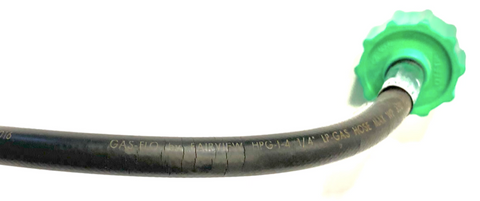The beginning of the travel season is a great time to give your propane system a 3-point safety inspection. The process is not complicated and doesn’t require any special skills.
To perform the inspection as we do, you'll need the following equipment:
- Small squirt bottle filled with soapy water
- (Optional) GasStop Safety Shutoff
1. Inspect the propane hoses
Rubber propane hoses may last anywhere from 2-5 years. The telltale signs of propane hoses that are at the end of their lifecycle include visible cracks in the rubber and stiffness. If your hoses exhibit either, replace them. Not doing so is unsafe and could lead to a propane leak.
To perform the inspection, simply open the propane cover and visually inspect the hoses for cracks, such as the ones shown in the photo below. Next, give each hose a squeeze to determine if it is stiff or hard to the touch.

We've seen many old propane hoses that are as stiff as concrete and show surface cracking. This is evidence that a dangerous leak could occur. Don’t let your propane hoses get to this state. Inspect and replace them before they fail.
If replacement is needed, consider upgrading from rubber to stainless steel braided propane hoses.
If you already have stainless steel braided propane hoses, know that on the inside are rubber propane hoses like the one in the above photo. Since you can't check them for cracks, we suggest replacing them every 2-3 years.
2. Perform a slow gas leak check
Although your propane leak detector (and probably your nose) will detect many types of propane leaks, a slow gas leak may be so small it is undetectable. Over time, however, a slow gas leak can be dangerous – which is why it's smart to detect it before things get out of hand.
How does a slow leak get started? It can be a loose fitting, a tiny crack in the propane line or an outdated appliance valve that needs replacing. We recommend performing a slow leak test prior to the first trip of the season, as well as every time you remove or return your RV from storage.
The easiest way to do this is using the GasStop Safety Shutoff. In addition to its primary function of automatically shutting off the flow of gas if there is a major leak, the device is ideal to use for identifying a slow leak. The basic steps using GasStop are:
- Turn the propane ON. If you have GasStop and the propane has been off, remember to prime the device 6-7 times to get gas flowing.
- Go into the Airstream and turn all gas appliances OFF. This includes the furnace, water heater, stove, and refrigerator if it runs on propane or is a hybrid.
- Go back outside and turn the propane OFF.
- WAIT. After about 4-5 minutes, check the GasStop valve. If the propane level has moved at all, you have a slow leak. Contact a service technician and have it checked out.
Our friend Brad Driver from Thirteen Adventures illustrates this procedure in this video:
If you don't have GasStop, you can follow the same steps, and after the waiting period, look at the propane regulator. If it has moved from green to red, you've got a leak.
3. Perform a “soapy water” test if a leak is suspected, OR if you had to replace the propane hoses.
In fact, any time you remove or replace a part – hose, regulator, or fitting – you must perform this test. You do NOT need to do this after the routine task of filling the propane tanks.
The simplest way to perform this test is to fill a small bottle with water and a few drops of dish soap. Squirt 3-4 pumps of the solution on each of the threaded brass connections, and examine it from all sides.
If a bubbling begins to occur at the connection, you’ve got a leak. What you’re looking for is bubbling that is continuous (not a few bubbles after you squirt, which are normal). See this video for an example.

If you’ve never done a soapy water test, watch how the procedure is performed, beginning at 3:30 in this video.
When you perform the soapy water test, make sure to test any connections that have been taken apart or are suspected to be leaking, including those to the:
- Water heater
- Furnace
- Stove
- Gas regulator
- Other appliances you may have installed, like a catalytic heater
The only connection you do not need to test with soapy water is the green knob on the tanks. Just hand-tighten it until it stops.


4 comments
Kat
We bought an electronic gas sniffer. They are not expensive, test for several kinds of gas, are very sensitive and way easier to use than soapy water especially in hard to reach places. We can also use to check the natural gas connections at home.
David Stubbs
I think in the slow leak text you meant to say off instead of back on.
Current text: “Go back outside and turn the propane ON.”
CPT(R) Richard D VanOrsdale
Good advice! Getting the stainless steel covered hoses and gas stop/gage systems was one of the best additions to our Airstream.
Rich Luhr
David, good catch! We’ve corrected the blog now.